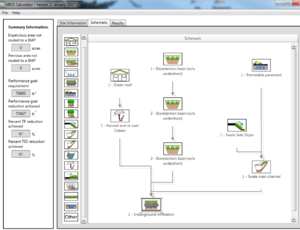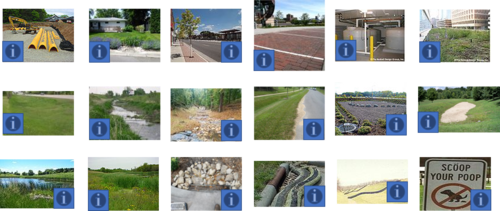
Difference between revisions of "Main Page"
m |
|||
| Line 20: | Line 20: | ||
*[http://stormwater.pca.state.mn.us/index.php/Alleviating_compaction_from_construction_activities Alleviating compaction from construction activities] | *[http://stormwater.pca.state.mn.us/index.php/Alleviating_compaction_from_construction_activities Alleviating compaction from construction activities] | ||
*[[Liners for stormwater management]] | *[[Liners for stormwater management]] | ||
| − | *[[Green Infrastructure for stormwater management]] | + | *[[Green Stormwater Infrastructure (GSI) and sustainable stormwater management]] |
| + | *[[Green Infrastructure for stormwater management]] - NOTE, this page will eventually be replaced by [[Green Stormwater Infrastructure (GSI) and sustainable stormwater management]] | ||
*[[Information on soil]] - <span title="1.Soil classification, 2.Soil texture and structure, 3.Soil erodibility, 4.Soil infiltration, 5.Soil properties, 6.Soil water storage properties, 7.Specific yields for geologic materials, 8.Design infiltration rates, 9.Determining soil infiltration rates, 10.Understanding and interpreting soils and soil boring reports, 11.Soil management, 12.Alleviating compaction from construction activities, 13.Erosion prevention practices, 14.Sediment control practices"> '''See contents'''</span> | *[[Information on soil]] - <span title="1.Soil classification, 2.Soil texture and structure, 3.Soil erodibility, 4.Soil infiltration, 5.Soil properties, 6.Soil water storage properties, 7.Specific yields for geologic materials, 8.Design infiltration rates, 9.Determining soil infiltration rates, 10.Understanding and interpreting soils and soil boring reports, 11.Soil management, 12.Alleviating compaction from construction activities, 13.Erosion prevention practices, 14.Sediment control practices"> '''See contents'''</span> | ||
*[[Compost and stormwater management]] | *[[Compost and stormwater management]] | ||
| Line 54: | Line 55: | ||
circle 820 510 30 [[Sediment control practices|Sediment control practices are designed to prevent or minimize loss of eroded soil at a site. Typical sediment control practices focus on 1) physical filtration of sediment by trapping soil particles as water passes through a silt fence, drop inlet screen, fiber roll, etc., 2)settling processes, that allow sediment to fall out of flows that are slowed and temporarily impounded in ponds, traps, or in small pools created by berms, silt fencing, inlet protection dikes, check dams, etc.]] | circle 820 510 30 [[Sediment control practices|Sediment control practices are designed to prevent or minimize loss of eroded soil at a site. Typical sediment control practices focus on 1) physical filtration of sediment by trapping soil particles as water passes through a silt fence, drop inlet screen, fiber roll, etc., 2)settling processes, that allow sediment to fall out of flows that are slowed and temporarily impounded in ponds, traps, or in small pools created by berms, silt fencing, inlet protection dikes, check dams, etc.]] | ||
circle 1040 500 30 [[Erosion prevention practices|Erosion prevention practices include 1) planning approaches that minimize the size of the bare soil area and the length of time disturbed areas are exposed to the elements – especially for long, steep slopes and easily erodible soils, 2) diverting or otherwise controlling the location and volume of run-on flows to the site from adjacent areas, 3)keeping concentrated flows in ditches stabilized with vegetation, rock, or other material, and 4)covering bare soil with vegetation, mulch, erosion control blankets, turf reinforcement mats, gravel, rock, plastic sheeting, soil binder chemicals, etc.]] | circle 1040 500 30 [[Erosion prevention practices|Erosion prevention practices include 1) planning approaches that minimize the size of the bare soil area and the length of time disturbed areas are exposed to the elements – especially for long, steep slopes and easily erodible soils, 2) diverting or otherwise controlling the location and volume of run-on flows to the site from adjacent areas, 3)keeping concentrated flows in ditches stabilized with vegetation, rock, or other material, and 4)covering bare soil with vegetation, mulch, erosion control blankets, turf reinforcement mats, gravel, rock, plastic sheeting, soil binder chemicals, etc.]] | ||
| − | circle | + | circle 1255 525 30 [[Pollution prevention|Pollution prevention (P2) is a “front-end” method to decrease costs, risks, and environmental concerns. In contrast to managing pollution after it is created, P2 reduces or eliminates waste and pollution at its source. P2 includes a variety of residential, municipal, and industrial practices.]] |
</imagemap> | </imagemap> | ||
| Line 81: | Line 82: | ||
==Models, calculations, methodologies, pollutant removal, credits== | ==Models, calculations, methodologies, pollutant removal, credits== | ||
*[[Minimal Impact Design Standards]] | *[[Minimal Impact Design Standards]] | ||
| + | *[[Minnesota Pollution Control (MPCA) Simple Estimator]] | ||
*[[Stormwater models, calculators and modeling]] | *[[Stormwater models, calculators and modeling]] | ||
*[[Stormwater pollutant removal, stormwater credits]] | *[[Stormwater pollutant removal, stormwater credits]] | ||
Revision as of 13:41, 1 March 2021
Information: We have begun adding hover box (mouse over) text so users can see the contents on a particular page. Hover your mouse over the bolded text See contents next to each link below to see the contents on the linked page.
Information: Taking advantage of the wiki technology, we continue to update this manual as resources allow. We continue to value your input. If you have comments or suggestions on the format please send them to us using the Help Improve this Page box at the bottom of most pages or send an email to Mike Trojan at the MPCA.
Welcome to the Minnesota Stormwater Manual website. This website was developed using Mediawiki, a wiki application that allows for easy editing and that has powerful search abilities. See Introduction to the wiki for more information.
Contents
- 1 Introduction to the Minnesota Stormwater Manual
- 2 Stormwater concepts and stormwater management
- 3 Stormwater issues
- 4 Stormwater control practices (Best Management Practices)
- 5 Regulatory, permitting
- 6 Models, calculations, methodologies, pollutant removal, credits
- 7 Case studies
- 8 Virtual tours
- 9 Communications and outreach
- 10 Stormwater research and education
- 11 Reference
- 12 Documents
Introduction to the Minnesota Stormwater Manual
Stormwater concepts and stormwater management
- General stormwater information
- Stormwater treatment concepts - See contents
- Alleviating compaction from construction activities
- Liners for stormwater management
- Green Stormwater Infrastructure (GSI) and sustainable stormwater management
- Green Infrastructure for stormwater management - NOTE, this page will eventually be replaced by Green Stormwater Infrastructure (GSI) and sustainable stormwater management
- Information on soil - See contents
- Compost and stormwater management

The Interstate Technology and Regulatory Council (ITRC) released a new guidance document called Stormwater Best Management Practices Performance Evaluation.
Stormwater issues
- Stormwater pollutants - See contents
- Stormwater infiltration - See contents
- Protection and restoration of receiving waters
- Minnesota specific issues - See contents
- Stormwater and landscape guidance for solar farms and solar projects
- Guidance for managing sediment and wastes collected by pretreatment practices
Stormwater control practices (Best Management Practices)
By type
- Construction stormwater Best Management Practices - See Contents
- Pretreatment practices - See contents
- Post-construction practices - See Contents
- Non-structural practices - See contents
- Structural practices - See Contents
- Stormwater and rainwater harvest and use/reuse
By treatment mechanism
- Pretreatment practices - See contents
- Filtration practices - See contents
- Infiltration practices - See contents
- Sedimentation practices - See contents
- Chemical practices - See Contents
Regulatory, permitting
- Construction stormwater: Permit, documents, fact sheets
- Municipal stormwater: Permit, documents, fact sheets
- Industrial stormwater: Permit, documents, fact sheets
- Regulatory information
- Additional regulatory information
Models, calculations, methodologies, pollutant removal, credits
- Minimal Impact Design Standards
- Minnesota Pollution Control (MPCA) Simple Estimator
- Stormwater models, calculators and modeling
- Stormwater pollutant removal, stormwater credits
- Unified sizing criteria
Case studies
Virtual tours
Communications and outreach
- Stormwater newsletters
- Stormwater blogs
- In the news
- Stormwater Manual webinars
- MIDS calculator videos
- MIDS training and workshop materials
- Stormwater videos
- Stormwater Manual and related presentations
Stormwater research and education
- Stormwater education
- Stormwater research
- University of Minnesota St. Anthony Falls Stormwater Research
Reference
- Minnesota Stormwater Manual photo galleries
- Tables
- Plant information
- Images, CAD drawings: Includes links to CAD drawings, photos, schematics, graphs, and other images
- Checklists
- Links to other stormwater manuals
- Miscellaneous information: Contains references, forms, links, issue papers
- Acronyms
- Symbols
- Glossary (definitions)
- BMP terminology
- Conversion units
- References from the original manual. NOTE: Newer reference lists are associated with topics on individual pages in the manual.
Documents
- pdf versions of Manual topics
- Technical support: Contains a variety of technical information used in developing the Manual


